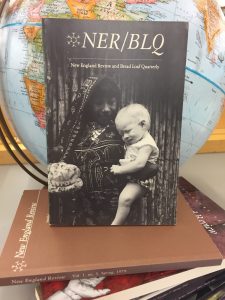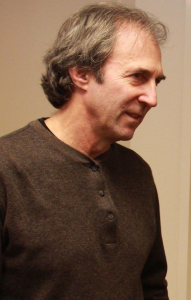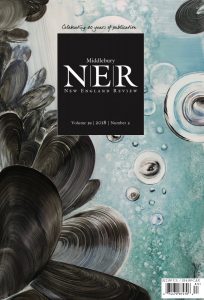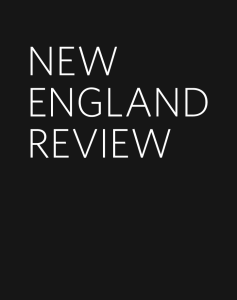
Former Managing Editor and Co-Editor Jim Schley introduces “While Mother Was Gone with 571” by Janey McCafferty from NER 6.4 (1984).
In the autumn of 1979, I’d graduated from Dartmouth with a degree in Creative Writing and Literature and a minor in Native American Studies. I made a list of jobs I would love to have, and working for a literary magazine was on top. I looked around the area where I was living, the Upper Valley region of central New Hampshire and Vermont, and realized that New England Review was right there, just north along the Connecticut River in Lyme, New Hampshire.
I’d taken courses from co-founder Jay Parini, but knew Sydney Lea only through mutual friends; yet this was well enough to write him a letter and ask if I could talk to him about helping with the journal.
From the start, Syd had vowed to read every submission that arrived, with characteristic passion. He was determined that the new journal would be completely receptive to the strongest writing that arrived, whatever its source. By the time I contacted him, there were hundreds of packets piling in every month, which was overwhelming. He asked if I’d be willing to review manuscripts with him for a modest rate, $5 an hour at first.
I started in January of 1980, and from the beginning this was an old-fashioned apprenticeship, as I learned in a bottom-to-top way the craft of editing, which has been my livelihood for most of the ensuing four decades.
Syd encouraged me to take the time I needed to carefully read and think about each piece, to the degree that I thought warranted, then send him with written comments on anything I believed should be given another look. I played this role for two years, even after moving from New Hampshire to western Massachusetts; once a month or so, I’d come north to meet with Syd and Managing Editor Robin Barone and pick up another large box of envelopes and mailers.
In 1982, when Robin decided to enroll in law school, they asked me if I’d be interested in becoming Managing Editor. Within a few months I’d moved to Lyme to take on the whole panoply of tasks involved in running a small but lively and growing nonprofit organization and producing a quarterly publication, as the sole person in the office. I did everything from bookkeeping and bill-paying and keeping minutes for meetings to preparing typed manuscripts for the designer and typesetter, distributing printer’s proofs to authors (always through the US mail), coordinating with the printer and mailing-list service, and continuing to read and correspond with aspiring and accepted authors, and tracking down artwork for the covers.
I learned so much. In those days, typeset copy came back from composition in long strips with waxed backing, which needed to be cut with an X-Acto knife and affixed to the blue-gridded templates created by designer Kate Emlen, who would review, adjust for positioning and typographical nuances, and approve my layout “dummies.” There were three desks and a work table in our office, and I would move from station to station for different duties. After two years, following my editing of the special issue Writers in the Nuclear Age (later reissued as a book Writing in a Nuclear Age), Syd asked me to become his Co-editor on the masthead, and first Mary Moore then Maura High served as part-time Managing Editors; Maura later became Co-editor.
My New England Review work was demanding and constant, but during those years I completed an MFA in the low-residency program at Warren Wilson College, and also worked intensively with the Vermont-based experimental troupe, Bread and Puppet Theater. For several summers I made a satellite office for New England Review in an old school bus at Bread and Puppet’s northern Vermont farm, where we produced the annual Domestic Resurrection Circus that attracted upwards of thirty thousand people for a climactic weekend of performances. By this time the journal had an affiliation with the Bread Loaf conference (and the ungainly moniker, NER/BLQ, which led my friends to jest that I really worked for the rockabilly band NRBQ). In 1986, as plans were being made to move the office to the Middlebury campus, I was invited to tour internationally with Bread and Puppet and decided not to accompany the journal to its new home, though Syd had built my position into the transfer agreement he’d created. I was worn out from reading thousands of manuscripts and wanted to see if I could focus on my own efforts as an artist.
Asked by New England Review’s present editor Carolyn Kuebler to choose a piece from my time as editor with special significance, I knew right away which one I’d name.
In 1983 we received in the mail a story called “While Mother Was Gone with 571” by Janey McCafferty, a writer none of us knew.
Looking back over the Summer 1984 issue, in which we placed McCafferty’s story first in the sequence, I’m enchanted to see the poetry, fiction, and literary prose published that season. Probably most journal editors feel that for each individual issue they are concocting a buffet, with contrasting and complementary elements, anticipating that varied readers will love different pieces, but aiming to bring together a tantalizing combination. That issue included extraordinary Vietnam poems by Yusef Komunyaaka, and poems by the now-deceased (but I hope not forgotten) William Dickey and Jim Simmerman. We featured a gorgeous and precise essay about Elizabeth Bishop by Michael Ryan, a strangely majestic story by Sharon Doubiago, and translations from the Marathi of Mangesh Padgaonkar, the Nicaraguan Spanish of Rosario Murillo, the Quebecois French of Anne Hébert, and the Cuban Spanish of Antonio Benítez-Rojo—and much more, each piece long considered, then chosen and placed. That issue’s cover has a mesmerizing picture of an indigenous Cuna woman in Panama with an albino “Moonchild,” taken by photographer Ted Degener.
There are many works of that I’m grateful and proud to have been part of bringing to the wider world, but the decision to publish Janey McCafferty’s story has made the biggest difference in my own life.
Readers will see that “While Mother Was Gone with 571” is taut, brisk, and hilarious. With a narration that’s audible and bright, in a voice as distinctive as Huck Finn’s or one of Grace Paley’s park ladies but with a teenager’s sass, the story blends shrewdly noticed details of time and locale with smacking dialogue and then climaxes with a rueful discovery. What commences as family slapstick in only a few pages darkens and chars, then concludes with a chill that’s hard to deflect.
After publishing McCafferty’s story, we decided to submit it for a Pushcart Prize, and for the nomination form I needed her date of birth. I wrote to the address we had, and heard back from her mother, since by then she was living elsewhere. The birthdate was within days of my own, and that November I sent her a birthday card out of the blue.
Thus began what has been an almost twenty-five-year pen-pal friendship. We’ve written well over a hundred letters to each other, for certain stretches more than a letter a week (there were times when we wrote every day): hundreds of sheets of notebook paper, and innumerable stamps. Sometimes we spoke by phone, but far more frequently we wrote letters. During these years we confided our work joys and woes, our romances and marriages, the births of our children, and the aging of our parents. One time when I was laid off from a job and felt sideswiped, barely able to speak, part of what got me through the rupture was writing Janey an eighteen-page letter.
But for the longest time, we’d never met—not till the 2008 AWP Conference in New York City, when we made our first in-person rendezvous, with long walks through the streets and bouts of laughter.
I can scarcely imagine being a writer without a friend who’s a writer, and this particular writer-friendship is especially complete. The serendipity of its beginnings is like any chance encounter: miraculous.
In my book of poems As When, In Season, there is a series in an invented form, nine portraits of women who have been my teachers in various ways, partly based on the imagery of the mythological Greek muses. As a child, I’d understood the muses to be not just inspirers of male artists, but virtuosos in their own right, in varied domains. For my evocation of Janey McCafferty and our epistolary friendship, I chose Thalia, muse of Comedy. Here’s the poem I wrote, “For Thalia.”
“While Mother was Gone with 571” by Janey McCafferty
**
 Jim Schley served as Assistant Editor, Managing Editor, then Co-Editor of New England Review from 1980 to 1986. In addition to his role at New England Review, Jim Schley has been a performer and tour organizer for several theater ensembles; managing editor and editor-in-chief for the book publisher Chelsea Green; executive director of The Frost Place museum and poetry center; and since 2008, managing editor of Tupelo Press. He has edited nearly two hundred books in varied genres and fields, and is author of the poetry chapbook One Another (Chapiteau, 1999) and a full-length collection of poems, As When, In Season (Marick, 2008). He lives on a land cooperative in Strafford, Vermont.
Jim Schley served as Assistant Editor, Managing Editor, then Co-Editor of New England Review from 1980 to 1986. In addition to his role at New England Review, Jim Schley has been a performer and tour organizer for several theater ensembles; managing editor and editor-in-chief for the book publisher Chelsea Green; executive director of The Frost Place museum and poetry center; and since 2008, managing editor of Tupelo Press. He has edited nearly two hundred books in varied genres and fields, and is author of the poetry chapbook One Another (Chapiteau, 1999) and a full-length collection of poems, As When, In Season (Marick, 2008). He lives on a land cooperative in Strafford, Vermont.

 NER was founded by poets Sydney Lea and Jay Parini in New Hampshire in 1978. In the fall of 1982 the magazine established an affiliation with the Bread Loaf Writers’ Conference and adopted the name NER/BLQ (New England Review/Bread Loaf Quarterly). In 1987, the magazine came under full sponsorship of Middlebury College, and in 1990 returned to its original name, New England Review.
NER was founded by poets Sydney Lea and Jay Parini in New Hampshire in 1978. In the fall of 1982 the magazine established an affiliation with the Bread Loaf Writers’ Conference and adopted the name NER/BLQ (New England Review/Bread Loaf Quarterly). In 1987, the magazine came under full sponsorship of Middlebury College, and in 1990 returned to its original name, New England Review.
 NER was founded by poets Sydney Lea and Jay Parini in New Hampshire in 1978. In the fall of 1982 the magazine established an affiliation with the Bread Loaf Writers’ Conference and adopted the name NER/BLQ (New England Review/Bread Loaf Quarterly). In 1987, the magazine came under full sponsorship of Middlebury College, and in 1990 returned to its original name, New England Review.
NER was founded by poets Sydney Lea and Jay Parini in New Hampshire in 1978. In the fall of 1982 the magazine established an affiliation with the Bread Loaf Writers’ Conference and adopted the name NER/BLQ (New England Review/Bread Loaf Quarterly). In 1987, the magazine came under full sponsorship of Middlebury College, and in 1990 returned to its original name, New England Review.